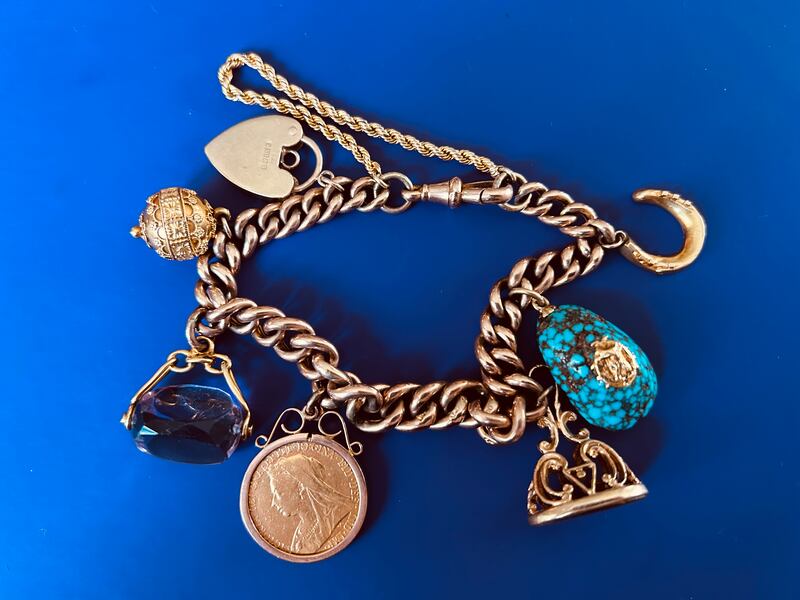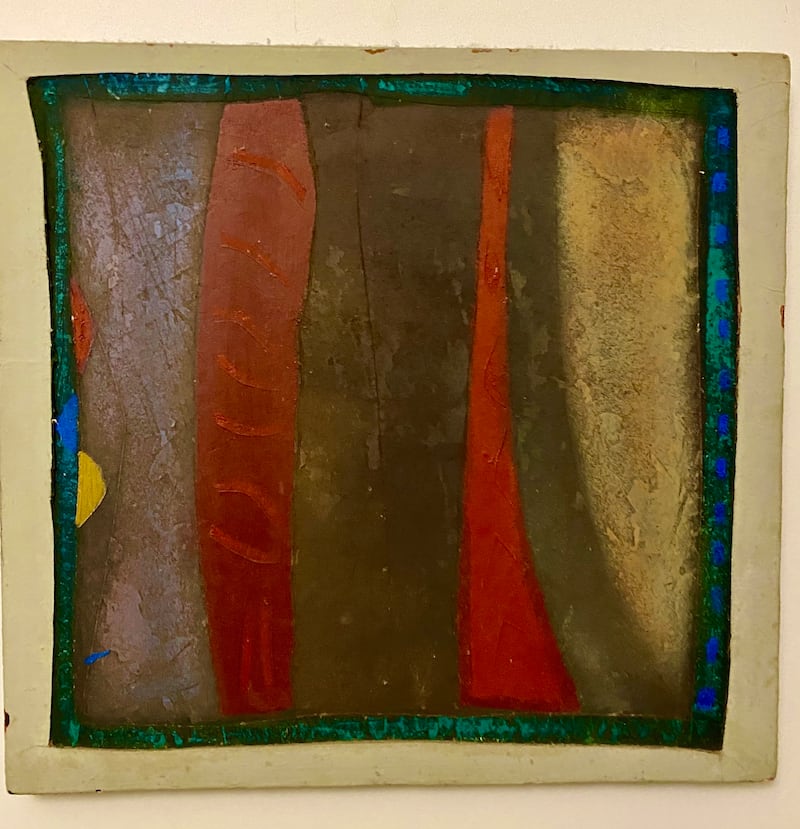You get to a stage of life when it feels a little tactless to visit your parents and inquire too closely about the family furniture. Who wants to look like they’re eyeing something up?
One recent evening, while watching reruns of Antiques Road Trip, I chanced to ask about the small and beautiful oval mid-century modern coffee table that these days labours under piles of old books, magazines and envelopes.
“Oh, my Dad made that,” said Mum.
We started to talk about other things. There’s a William III card table my grandmother left to my brother; a heavy gold bracelet my grandfather gave me when I was two; and a trio of figurines my granny kept, complete with boxes and receipts, believing that they would one day set me up for life. I know their value to me – even though I’m not sure I’d be in a rush to put them on the mantlepiece.
READ MORE
But what are they actually worth?
On a purely practical level it doesn’t actually matter who owned something – although as all auctioneers know a decent spot of provenance can add cachet (and cash) to the sales price. Smaller family histories can be more fragile, and when things get separated from their stories a lovely part of their value evaporates. So even if you are feeling bashful do ask about items, if only to keep their stories alive.
Here we talk to Adam’s Auctioneers about the value of some of the things I, and other readers, treasure most.
The trio of Royal Worcester figurines: €30-€50
According to the receipts my grandmother painstakingly kept these figurines cost more than£200 each. But what are they worth now?
“Modern Royal Worcester figurines were, and still are, expensive to buy retail but unfortunately they have a very poor secondary market value,” says James O’Halloran of Adam’s. “Figurines like these may even struggle to sell as younger buyers have no interest in collecting such pieces. Serious collectors have yet to discover their charms,” he says tactfully, estimating them in the €30-€50 range.
Gold bracelet: €800-€1,200
Claire Mestrellet, Adam’s head of jewellery, took a look at the bracelet, and at 9ct said it would have an estimate of €800 -€1,200, which is more, I was pleased to hear, than the scrap value of approximately €600-€700. But what stranger would value the letter that accompanied this gift all those years ago? I may not generally sport heavy gold bling but I would never part with the piece.

William IV card table: €200-€400
Surprisingly the card table is worth even less. O’Halloran confirms that it is a William IV/George IV rosewood table, dating to about 1820. “No one is living the way we used to live, even 25 years ago,” he says. This means items such as display cases, card tables and sewing tables (yes, I have one of those too), have lost a great deal of their value, and he estimates this one at €200-€400. This shows, however, that if you think outside fashion, and are looking for sturdy, beautiful and long-lasting pieces made of gorgeous hardwoods, the auction world is currently your oyster.
And how did our readers do?
The wedding present: a Georgian chafing dish: €50-€100
Poppy Hunt got this dish as a wedding present at a time when wedding presents were things you needed to set up your new home together.
“We hadn’t asked for a kettle, and to be honest the giver was someone known for their taste and generosity so when I unwrapped the package and found a Russell Hobbs box, I put on one of those ‘so delighted’ faces and planned to exchange it once the honeymoon was over. I had composed the thank you letter, and the box was in the car when I decided to have a quick check that everything was intact.”
Hunt quickly discovered, however, that it wasn’t a kettle at all but a beautiful antique chafing dish.
“There’s a stopper in the body, where you pour in hot water. It’s meant to keep your muffins warm, or something like that. I did use it once for eggs when we were having a fancy breakfast,” she says, “these days it sits on a table in the livingroom, and it’s a handy spot to hide things in, so you never know quite what you’ll find. It’s quite weighty, and there are marks that look like a hallmark on the underneath. When someone gives you something as a gift you can’t really ask what they paid for it, especially if you thought it was a kettle. But I have often wondered what it’s worth.”
The answer? Well, O’Halloran says the dish is attractive “but sadly is silver-plate”.
“This means it simply has a use/decorative value. It is dated about 1880 and the marks on the base are makers’ marks, which were designed to look like hallmarks to the uninitiated.”
He gives an estimate of €50-€100 on it, and Hunt says that it’s a relief not to have to insure it. “I have always loved it, and you can buy a new kettle any time!” she says.
The Artwork: painting by Tony O’Malley: €3,000-€5,000
Patrick Murphy met renowned Irish abstract painter Tony O’Malley back in 1982, and bought this painting in about 1984. “It was sold to me as a pair,” he recalls, “the second of which wasn’t so strong”.
The painting is dated 1976, and has an interesting frame, which O’Malley made out of canvas, cut to shape around the wooden panel on which it is painted.
“It has gorgeous turquoise skid down one side, and all the hallmarks of an O’Malley. Interestingly, I came across a similar thing again, where the same dealer had put a weaker painting with a strong one, and said they came as a pair. There’s a lesson in that.
“It has lived with me all over the world. It is like a friend now. Sometimes I ignore it and don’t see it. Sometimes it gets hit by a shaft of light and it reveals itself all over again. It is wonderful. It’s invaluable to me. I wouldn’t part with it. I think I paid £400 [€507.90] for the pair.”

James O’Halloran at Adam’s says: “This mid-1970s work is probably from his St Ives period. It has rich, but quite dark tones. O’Malley’s Bahamas and Canary Islands works, with their wonderful colours, are much more sought after and can achieve much greater prices.”
O’Halloran gives an estimate of €3,000-€5,000. Given that Murphy paid IR£400 for the pair of paintings it would make them about £200 each. Based on inflation rates £200 in 1984 would be worth just over €650 today, proving that a good eye and good timing can make art an excellent investment.
The Handbag: 1950s Christian Dior: €200-€400
Wexford-based Kathleen Byrne didn’t know anything about this Christian Dior handbag until her Mum died three years ago.
“We were going through her bits and pieces. She didn’t have that many handbags, but the minute I saw it I knew it was a good one. I never saw her with it, but there are two ways she could have come by it. She worked in England before she got married in a big store. So she either bought it there or when she came back to Ireland – she was working for a family in Gorey, who may have given it to her.
“I love watching antiques programmes, and I’d love to find out more about the bag. I took photographs and sent them to Dior, but didn’t find out anything. All the metal pieces are stamped, and Mam definitely used it, but I’m afraid to clean the leather because I don’t want to damage it, and I want to give it to my daughter.”
So are designer handbags “investment pieces” like the marketers say?
Clearly some more than others, and the resale value is greater the less you put things in them.
The team at Adam’s say that Dior is not one of the principal brands that generates big prices for collectors of vintage pieces. It has also been well loved and used, and even in great condition it might be worth just €200-€400.
However, Kathleen’s daughter Karen says now that she knows she’s not carrying the crown jewels around she’s looking forward to actually using it and enjoying it.
The Family Heirloom: Victorian hunting horn: €200-€300
Sophie Motley was always obsessed with horses as a child living in the city.
“I was given a book about them, had riding lessons, and I practised tying up ropes on the foot of my bed. I felt it was in my blood but none of my family had an interest,” she recalls.
Her family eventually moved to the countryside, where her neighbours let her ride their old pony.
“I loved it, and I’ve somehow always found time for horses in my life. Even as a theatre freelancer with nothing, people would let you exercise their horses. I wrote my dissertation on horses in performance, and have always had an interest in them, socially and culturally.”
When her grandmother died, Motley was left the horn in her will.
“I didn’t know that there had ever been a connection to horses in my family. It belonged to my great great grandfather, who must therefore have ridden a horse, as there was a hunt nearby to where he lived. Horses are in my blood! This discovery was very exciting. It led to an interest in instinct and the notion of skills or culture being inherent, which led to me creating a beautiful show with dancer Emma O’Kane called JOCKEY, where Emma learnt to ride a racehorse having discovered her grandfather had been a bloodstock agent. Animals are part of who you are, and this discovery has led me on so many interesting paths, to creative projects, rural stories and doing my best to represent rural communities through my work and my life.”
But does the item have a significant monetary value? Well, the team at Adam’s say that generally only hunting horns that belonged to a well-known person are of particular interest at auction. The ones you come across are unsurprisingly often battered and bruised. Motley’s example is Victorian, so it’s seen plenty of sport, and it gets an estimate of €200-€300.
For Motley, however, the valuation doesn’t change anything “It’s an item that represents something more even than sentimental value. It’s about values and instinct. Still, it would be good if I was broke!”
- Sign up for push alerts and have the best news, analysis and comment delivered directly to your phone
- Find The Irish Times on WhatsApp and stay up to date
- Our In The News podcast is now published daily – Find the latest episode here
















